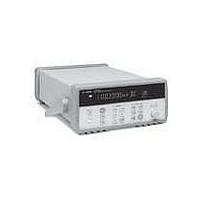34907A AGILENT TECHNOLOGIES, 34907A Datasheet - Page 15

34907A
Manufacturer Part Number
34907A
Description
Data Acquisition Switch Unit
Manufacturer
AGILENT TECHNOLOGIES
Datasheet
1.34905A.pdf
(28 pages)
Specifications of 34907A
Input Current Max
400mA
Bandwidth
100kHz
Input Voltage Max
42V
Lead Free Status / RoHS Status
na
Spec interpretation guide
The following pages list the technical specifications for
the Agilent 34970A/34972A Data Acquisition/Switch Unit
and its modules. The explanations and examples below
are helpful in understanding how to interpret these
specifications:
• Measurement accuracy is specified as percent of
• DMM measurement accuracies include all switching
• Accuracies are listed as either 24-hour, 90-day, or 1-year
Example 1: Basic dcV accuracy
Calculate the accuracy of the following measurement:
9 V dc input
10 V dc range
1-year accuracy specifications
Normal operating temperature (18 °C – 28 °C)
From the following page, the 1-year accuracy is:
0.0035% of reading + 0.0005% of range
reading plus percent of range, where reading is the
actual measured value and range is the name of the
scale (1 V, 10 V, etc.)—not the full scale value (1.2 V,
12 V, etc.).
errors. Switching errors are also listed separately in the
module specifications section. Temperature measurement
accuracies include ITS-90 conversion errors. The thermo-
couple accuracies include the reference junction error
as well.
specifications. This refers to the length of time since the
instrument’s last calibration. Use the specification that
matches your calibration cycle. The 24-hour specifica-
tions are useful for determining short-term relative
performance.
Which translates into:
(0.0035/100 x 9 V)+
(0.0005/100 x 10 V) = 365 µV
For a total accuracy of:
365 µV / 9 V = 0.0041%
Example 2: Extreme operating temperature
When the 34970A/34972A is used outside of its 18 °C –
28 °C temperature range, there are additional temperature
drift errors to consider. Assume the same conditions in
Example 1, but at a 35 °C operating temperature.
The basic accuracy is again:
0.0035% of reading + 0.0005% of range = 365 µV.
Now, multiply the 10 V temperature coefficient from the
following page by the number of degrees outside of
operating range for additional error:
(0.0005% reading + 0.0001% range)
(0.0005% reading + 0.0001% range)
0.0035% reading + 0.0007% range = 385 µV
Example 3: Thermocouple measurement accuracy
Calculating the total thermocouple reading error is easy
with the 34970A/34972A—just add the listed measurement
accuracy to the accuracy of your transducer. Switching,
conversion, and reference junction errors are already
included in the measurement specification.
For this example, assume a J-type thermocouple input
reading 150° C.
From the following page, total error is:
Thermocouple probe accuracy + 1.0 °C
The probe vendor specifies accuracy of 1.1 °C
Example 4: acV accuracy
The acV function measures the true RMS value of the input
waveform, regardless of waveshape. Listed accuracies
assume a sinewave input. To adjust accuracies for non-
sinusoids, use the listed crest factor adder.
For this example, assume a ± 1 V square wave input with
50% duty cycle and a 1 kHz frequency.
Accuracy for 1 V, 1 kHz sinusoid is:
0.06% reading + 0.04% range
A 50% duty cycle squarewave has a crest factor of
/ °C x (35 °C - 28 °C) =
/ °C x 7 °C =
Total error is then:
365 µV + 385 µV = 750 µV or 0.008%
or 0.4%, whichever is greater.
Total error is then:
1.0ºC + 1.1ºC = 2.1ºC total, or 1.4%
Peak value / RMS value = 1 V / 1 V = 1
From crest factor table, add:
0.05% of reading
The total accuracy is:
0.11% of reading + 0.04% of range = 1.5 mV or 0.15%
15











